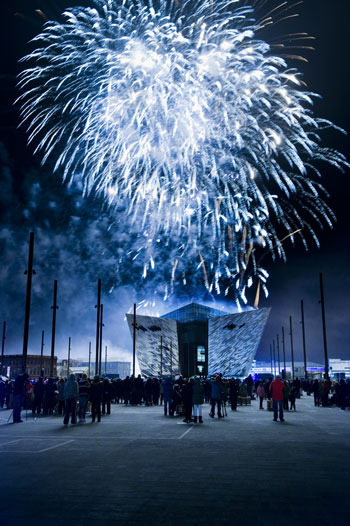Northern Ireland
 Belfast, the capital of Northern Irelandis a port city and the country's largest industrial and commercial hub, but, with the tremendous economic growth seen in recent years, it is more than that, and has become and artistic and cultural centre.
Belfast, the capital of Northern Irelandis a port city and the country's largest industrial and commercial hub, but, with the tremendous economic growth seen in recent years, it is more than that, and has become and artistic and cultural centre.


 A good example of this change is the new Titanic Museum which opened in 2012, housed in an iconic building located on the slipways where the legendary ocean liner was built. If you like the atmosphere of typical Irish pubs, there are a lot to choose from, but the Crown Liquor Saloon is worth a visit: a classic Victorian bar restored to its original splendour and owned and preserved by the National Trust.
A good example of this change is the new Titanic Museum which opened in 2012, housed in an iconic building located on the slipways where the legendary ocean liner was built. If you like the atmosphere of typical Irish pubs, there are a lot to choose from, but the Crown Liquor Saloon is worth a visit: a classic Victorian bar restored to its original splendour and owned and preserved by the National Trust.
The major tourist attraction in the country is in County Antrim in the North: the world famous Giant's Causeway. Visitors are overwhelmed by the sheer number and size of the volcanic basalt columns. Legend has it that the Causeway is the remains of the bridge built by the Irish giant, Finn McCool, linking Ireland to Scotland. There are a number of ways you can discover this site, unique in Europe, and all provide the most amazing and original photo opportunities.
The whole of the coastline is very beautiful, with changing skies and the sun low on the horizon due to the latitude: the atmosphere you see and feel is quite often unreal. Nine Glens cut deep swathes into the Antrim plateau down to the coast, providing an outstandingly beautiful landscape, in a variety of authentic hues, colours and textures. Further South, in County Down, the intriguing Ards Peninsula stretches some forty kilometres, separating the still waters of Strangford Lough, the largest inlet in the British Isles, from the Irish Sea: the countryside here is untouched and sometimes wild. Discover the many authentic but picturesque fishing villages, numerous castles and Victorian country houses set in luxuriant gardens, particularly the National Trust owned and run Mount Stewart House with its own Temple of the Winds.
In the interior, County Fermanagh is reminiscent of Scandinavia with its forests and lakes: the second largest Lough Erne, is in fact two connected lakes, the Upper and Lower Erne, with 154 islands and many coves and inlets. Enniskillen, lying on the short stretch of the river Erne which connects the two lakes, is well worth a visit, as is the neo-classical mansion Castle Coole, and the limestone Cliffs of Magho which have magnificent views stretching for miles. This region is a paradise if you like to fish, walk or sail.
Protecting the environment, flora and fauna is very important in Northern Ireland, which has many nature reserves: one of which is the distinctive glaciated landscape of the Sperrin Mountains, stretching from South of the famous walled city of Londonderry, the Second City, to the West of County Tyrone. The American Folk Park, an open-air museum in Castletown, just outside Omagh in County Tyrone, tells the story of immigration from Ulster to America in the 18th and 19th Centuries.
Northern Ireland also offers many outdoor and sporting activities, but a special mention must be given to golf, with over eighty courses. Two particularly outstanding golf courses are the world famous Royal County Down and Royal Portrush, both links courses.
------
(*) Northern Ireland is made up of six of the nine Counties which formerly were the traditional province of Ulster: namely Antrim, Armagh, Derry, Down, Fermanagh and Cavan. Northern Ireland is part of the United Kingdom.
Luxury hotels and designer Bed and Breakfasts, Business hotels and Secret places










